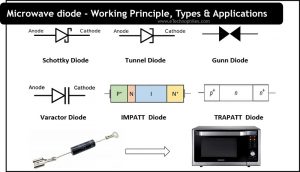Last updated on April 2nd, 2024 at 11:22 am
Microwave diode is just a general term for diodes that are used in different microwave devices. Many popular diodes can be considered microwave diodes. Like PIN diode, Gunn diode, Tunnel diode, etc.
All these diodes operate in the microwave frequency band (300 MHz to 300 GHz). In this article, we will discuss the working principle of microwave diodes, their types, and applications.
Note: In this article, we will discuss two categories of microwave diodes, the first which can help to generate a microwave signal, the second which can only operate in a microwave frequency band and is used in different microwave devices.
Table of Contents
Working principle
Two fundamental effects will help us to understand the working principle of microwave diode: The Negative Resistance Effect and the Point Contact Diode Effect.
The negative resistance effect
The negative resistance (NR) effect shows the relationship between the current and voltage. With the increase in voltage, the current flowing through the diode decreases. This effect helps to convert electrical energy into microwave radiation energy at a very high frequency.
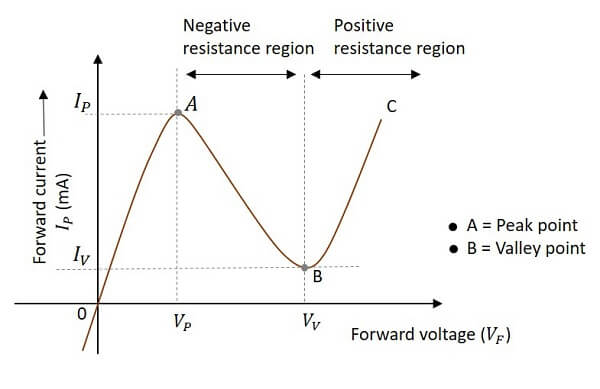
The figure above shows the I-V characteristics of a nonlinear diode. We can understand the negative resistance effect by dividing this figure into three sections.
- In the first section between zero to point A, the current increases with an increment in forward voltage and follows Ohm’s law.
- But when the current reaches the peak point, it shows the negative resistance effect. So in the second section between points A to B, the current value decreases with an increment in voltage until it reaches valley point B.
- Again after points B to C, the current follows Ohm’s law and shows the same behavior as the first section.
Point contact diode effect
When a metallic wire is connected with an N-type semiconductor to form a small junction, this small point junction possesses a small value of junction capacitance. Due to this small capacitance, the charge stored at the junction and its transient time decrease.
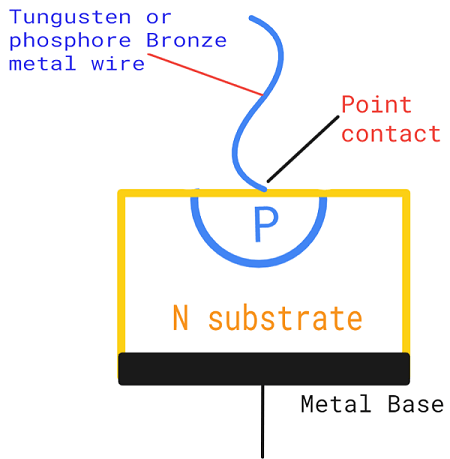
And since the transient time of the junction capacitor decreases, the switching speed of microwave diodes increases much better than normal P-N junction diodes.
How does a diode generate microwaves?
The microwaves are generated by high-frequency oscillators. Some microwave oscillators are the Tunnel diode oscillator, Gunn diode oscillator, IMPATT diode oscillator, etc.
For example, Consider this tunnel diode oscillator shown in the figure below. It consists of two resistors and a tank circuit (parallel LCR circuit) connected to the input voltage source.
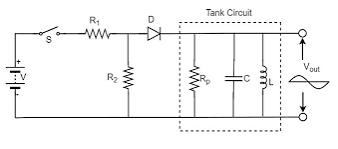
When the input voltage of the tunnel diode lies between point A to point B, the negative resistance effect occurs. And due to this negative resistance effect, the current in the tank circuit changes. The inductor in the circuit opposes this current change and generates a positive voltage to maintain the previous current value.
When the diode’s current changes from point B to point C (the positive resistance region), the reverse process occurs. Here, the tank circuit generates the negative voltage to resist the positive rate of change in current.
Similarly, when this change of current in the tank circuit varies again and again between point A to B and next B to C in a loop, then the output voltage of the tank circuit will also repeat the same process (generate positive voltage and negative voltage respectively).
So this positive-to-negative and again negative-to-positive variation in the output voltage of the tank circuit generates a sinusoidal wave that can work as a microwave signal.
Note: We can adjust and change the output frequency of the microwave voltage signal with the help of the tank circuit’s oscillation parameters.
Why are microwave diodes used in microwave devices?
As discussed above, microwave diodes have a higher switching speed. Therefore, to transmit or receive a signal at microwave frequencies (approx. 300 MHz to 300 GHz), the device must have a diode that can work properly at a very high switching speed. This is why we use microwave diodes in microwave devices.
Types of Microwave diodes
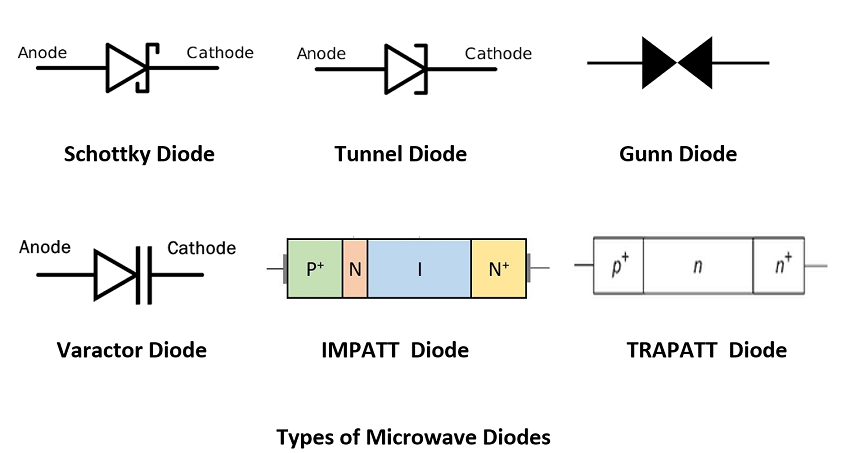
According to their applications, microwave diodes can be divided into three categories:
- Low-noise receiving devices: Point contact diode, Schottky barrier diode, and Parametric varactor diode.
- Control devices: Electrically tuned varactor diode, PIN diode.
- Microwave power source devices: Power Varactor diode, Body effect diode, Step recovery diode, IMPATT diode, tunnel diode, and Gunn diode.
Gunn vs Tunnel vs PIN diode
The fundamental differences between various types of microwave diodes are based on their structures, working operations, frequency range, output power efficiency, and uses. For example,
- Gunn diode is a bulk electron transfer device but the IMPATT diode is a junction-type electron transfer device.
- The tunnel diode has 5 to 10% output power efficiency while the TRAPATT diode has 20 to 60% output efficiency.
- PIN diode has a very high switching speed so it is used in microwave control devices while the Schottky diode has very low noise power so it can be used in low noise receivers in radio communication devices.
Application
Microwave diodes have the advantages of small size and high reliability. These advantages make them suitable for microwave oscillation, amplification, frequency conversion, switching, phase shifting, and modulation. Microwave diodes have various applications. Some of them are:
- Microwave Ovens.
- Wi-Fi. Bluetooth.
- Communication Systems.
- Medical Equipment.
- Weapons and Military Equipment.
FAQs
Are all microwave diodes the same?
No, all microwave diodes are not the same. Microwave diodes are available in different types and each has its own VI characteristics, operating frequencies, applications, and power efficiency. According to their applications, they even have different operational circuitry. Therefore we can say that all microwave diodes are not the same.
Which diode is used in a microwave oven?
Microwave diode such as Power Varactor diode, can work at a very high-power microwave signal and is used as a rectifier in a microwave oven.
Can a microwave oven work without a diode?
No, a microwave oven can’t work properly without a diode. The microwave diode converts alternating current (AC) to direct current (DC), which increases the voltage and powers up the oven’s magnetron. Without a proper voltage level, the magnetron will not generate the microwaves that heat the food.
Can we use P-N junction diodes in microwave devices?
PN junction diodes cannot be used in microwave devices. Since the P-N junction diode is the simplest semiconductor diode it can not operate at a very high switching frequency. So due to its low switching speed, we cannot use it as a microwave oscillator.
